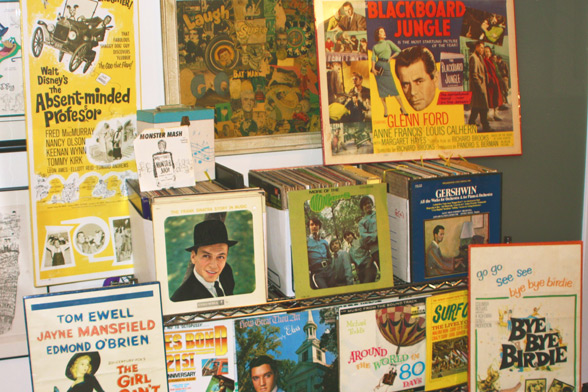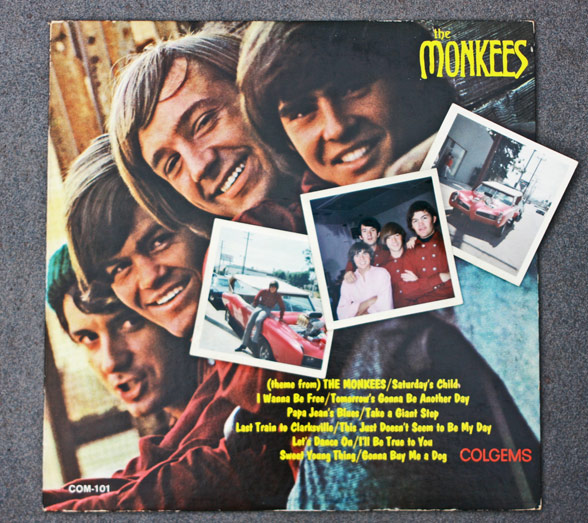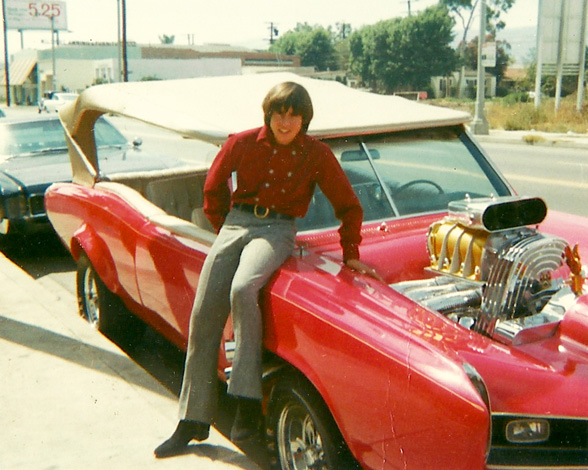The Record Store and Vinyl Records AKA Bruce’s Guide to the Evolution of Technology and His Kandy-Kolored Tangerine-Flake Streamline Baby*
With Guest Co-Author, Professor David E. Weber
The Evolution of Technology series continues with the record store and vinyl records, aka lps, records. Going to the record store now seems such a quaint memory, sort of like the Beav going to the soda fountain. But, vinyl records and record stores were a big part of our lives back in the day!
My oldest friend in the world is David E. Weber, a professor at the University of North Carolina Wilmington. We actually met in nursery school, as pre-school was called when we grew up, and have been in touch for the five decades since.
He’s led a wonderfully adventurous and eclectic life, but now is relatively settled given he’s a tenured professor of communication studies. That doesn’t stop him from continued exploration of the world, as he recently returned from being a guest professor in Vietnam.
Professor Weber earned a Ph.D. in Communication from University of Denver in his late forties. Prior to that, he had a career in organizational development for almost 20 years, including five years as an expatriate executive in Asia. His academic specialty area is communication in international business organizations.
DW, as I’ve fondly called him for longer than I can remember, has his very personal recollections about record albums and record stores. As he and I both grew up in Los Angeles, we roamed the city, especially Hollywood, where THE record store of the stars, Wallach’s Music City, filled the corner of Sunset and Vine. For its radio commercials in the ‘50s and ‘60s, Wallach’s would engage a major star of the era, such as Doris Day, to introduce himself or herself, pause, and then, to the tune of “Rock-a-bye Baby,” sing three words: “It’s Music City!”
Wallach’s had an extensive collection of guitars, drums, studio recording equipment and sheet music as well as a massive collection of record albums of all music genres. In the ‘60s, a variety of L.A. residents – hippies, refined classical music types, some country fans and young teenyboppers – filled the store’s famous listening booths, where like the sidewalk cafes of Paris, you could stay as long as you wished. Top entertainment stars visited Wallach’s: On different occasions, DW remembers seeing Steven Stills, Scruffy Weir (of The Grateful Dead) and Joni Mitchell standing within arm’s reach among the vinyl albums.
David and I were frequent visitors of our local record stores and would occasionally pedal our Schwinn bikes all the way to Hollywood and walk in awe through Wallach’s Music City. Records and music were part of our teenage initiation and our first stab at seriously distinguishing ourselves from our parents. It was very important to us.
DW teaches courses primarily in business and organizational communication, but also teaches, lectures and writes about the history of technology, and the emerging relationship between digital technology and culture. He has, from the point of view of a communication professor, some great memories to share of the impact that record albums and his collection of them had on his life. Here are some of those memories, which I would like to share in this edition of “The Evolution of Technology.” Take it away, Professor Weber:
At its peak, my collection of vinyl albums numbered about 200. In contrast, some of my friends had well over 2,000 albums. But nearly every one of my records had sentimental meaning for me; I had limited interest in pure acquisition or casual accumulation. I also owned about 150 45-r.p.m. records, most of which also evoked special memories. All of that ended on a stormy Wednesday in September 1999, when all of my vinyl was destroyed under four-plus feet of water in a flood.
My record collection had grown, shrunk, changed and relocated with me throughout four decades. The flood of ‘99 destroyed The Turtles Greatest Hits — the first stereo album I had ever bought, back in about 1967, at age 14. My favorite album as a little boy was an early 33⅓ RPM album my dad had bought before I was even born. On it the University of Michigan Men’s Glee Club’s sang a capella renditions of famous university songs. It too was ruined by the flood.
Also taken from me were Days of Future Passed, In Search of the Lost Chord (Deluxe Edition), and Every Good Child Deserves Favor — albums by The Moody Blues. I began accumulating them in college, when one young woman I wanted to impress said she loved the group.
In 1999, my copy of The Beatles’ The White Album consumed by the flood still had all of its extras — the scruffy photos, the poster-size photo collage of note pages containing the lyrics. The album, a Christmas present at age 15 or so, represented one of my first excursions away from an obedient and straight-arrow life.
After high school, whenever my friends and I changed residences, we would haul our vinyl treasures with us, stacking them in orange crates We shredded our fingers with splinters as we loaded and unloaded the heavy boxes.
We bought most of our albums in record stores. In college towns, these often were like community centers, much as Starbucks outlets are today. In a store’s cut-out bins — boxes or racks of new albums, priced at 25 or 50 cents each, that record companies had decided to stop pressing — one often found quirky, even bizarre, no-one-else-will-have-this recordings. Thus did My Russian Homeland by Ivan Rebroff come into my possession.
Playing an album was easier than landing on an aircraft carrier but more complicated than making scrambled eggs. Remove the record carefully from its sleeve — don’t drop the disc on the lint and dirt on the carpet! Now, run the dust remover slowly over the playing surface. Touch only the edges of the disc as you lay it slowly onto the turntable and ease the needle arm up and away and onto the record. A half-hour or so later, the rhythmic nsk, nsk nsk that will signal the end of the side; grab the arm before the needle careens onto the paper label!
Acquiring, transporting, storing and playing recorded music has changed from being primarily a physical task sometimes requiring use of the whole body, to a process calling for only the use of a finger. Pushing “play” or “shuffle” or shuffle on your iPod replaces the minor surgery involved with playing a record in the vinyl era. A stroke or two on your keyboard accesses websites like iTunes where songs and albums are yours as soon as you click “OK.” You need never visit a “music city”—which means, though, you never bring a record home and inhale the scent of cut cardboard as you pull away the cellophane wrapper. One’s identity, once defined by the contents of orange crates, is now conflated with the contents of a digital playlist.
Wow, I enjoyed reading DW’s memories while I’m surrounded by hardware that, to say the least, makes my vintage Hitachi transistor radio look its age. He’s my only friend who has an encyclopedic memory and I often refer to him as my personal memory bank! He remembers things about my life, just from stories I’ve told him, that I’ve long forgotten.
I will only share one memory of my early teen record store days and the amazing thing that occurred on my bicycle ride there.
It was the summer of 1966 and as I was heading to my record store, The Frigate, when I saw what turned out to be a George Barris original design custom car. It looked amazing in its pinkish color so I stopped to take a look. Nearby, I heard music coming from an open door. I looked in and saw a band playing, under lights and against a white backdrop, as photographs were being taken.
I gingerly walked in and was greeted very nicely by the band. They were taking photos for a new television series. I met Mickey, Davey, Michael, and Peter and learned they were The Monkees and they were going to have a new series premiering in the fall (note: The Monkees TV series premiered in September, 1966 and lasted until just March, 1968).
I asked the guys if I could pedal home and get my Instamatic camera. They agreed and I took a few photos. In those days, it was less customary to jump into the picture so, sadly I’m not in any of them. But I was sure I had lost those photos years ago. Happily, I found them again when I was searching through my memorabilia boxes for my first Evolution of Technology article and found my first transistor radio and, to my great surprise, these original photographs.
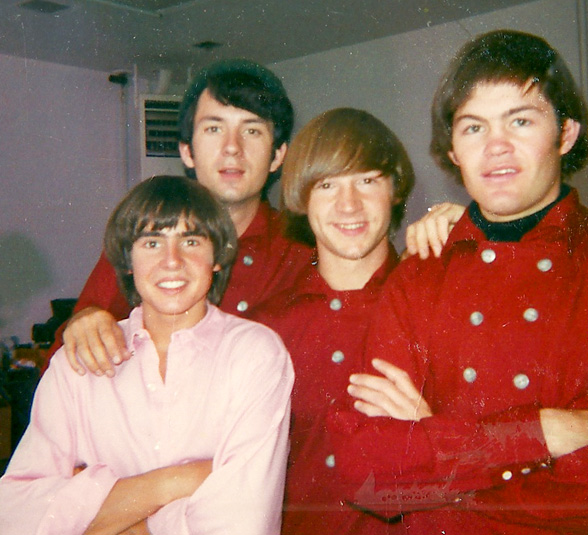
My photo, taken with my Instamatic, of “The Monkees” in June, 1966 (Photo by 12-year-old Bruce Sallan)
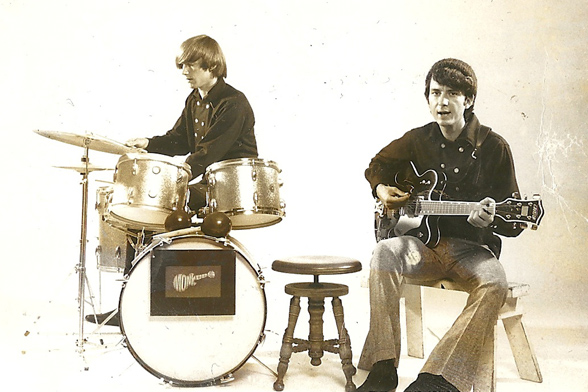
Peter Tork and Michael Nesmith during Photo Shoot – proof photo taken on same day and given to Bruce by The Monkees
Records. Albums. Vinyl. Lps. I thought these terms were part of my past, my tech history, but was surprised when our resident cartoonist, my son Aaron Sallan, used the record as a joke in one of his It’s a Tech World After All cartoons, which may be his most popular comic to date.
So, given our personal nostalgic memories, I am curious to hear of your memories of records, albums, and record stores?
*an homage to Tom Wolfe’s first collected book of essays, published in 1965

